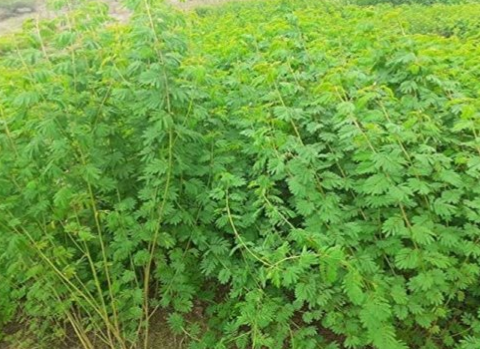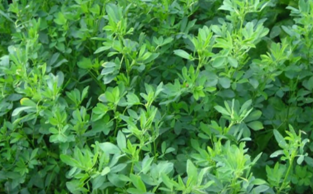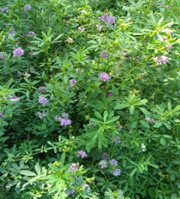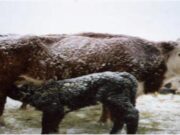
Introduction
Lucerne is a minor crop but protein rich fodder otherwise called as Alfalfa (Medicago sativa) is a leguminous forage crop. It is one of the most important legumes used in agriculture also termed `Queen of forages’. The US is the largest alfalfa producer in the world, but considerable area is found in Argentina, Australia and South Africa. It is known as Kuthirai masal in Tamil, is mostly grown in the Coimbatore district of Tamil Nadu.
It is a cool season perenniallegume growing from one to threeyears, depending on variety and climate.Alfalfa is highly nutritious and a natural source of nitrogen.
It produces small bunches of purple flowers with maximum height of up to one metre and has a deep root system which enables to produce good yields even under moisture stress conditions. This makes it very resilient, especially to droughts. Its extensive root system nourishes both plants and soil. It’s ideal for improving the soil and providing erosion control
Like other legumes, its root nodule shaving bacteria, Sinorhizobiummeliloti, with the ability to fix nitrogen resulting a high-protein rich fodder. Its nitrogen-fixing abilities, which increases soil nitrogen and use as animal feed greatly improved agricultural efficiency.


Kuthirai Masalis widely grown throughout the world as forage for cattle mostly harvested as hay, but can also fed as green chop. Kuthirai Masal has the highest feeding value crop being used less frequently as pasture. Alfalfa has a wide range of adaptation and can be grown from very temperate agricultural regions to Mediterranean climates.
Its primary use is as feed for dairy cattle, and secondarily for horses, goats and sheep. Alfalfa is believed by some to be a galactagogue, a substance that induces lactation. It contains an elevated amount of calcium, vitamin E and carotene which areof major importance for milk production.
Suitable soil and location
Kuthiraimasal is suitable for wide range of soil types. Even though suitable for all type of soils fine and firm seedbed must be prepared for take up sowing.Heavy soil types may be avoided since the crop will not tolerate a waterlogged condition. Sufficient drainage to be provides so that the soil compaction could be avoided further, too much moisture can lead to mold growth.
Soil pH
Lucerne has a high requirement for calcium so that soils that are well drained with a pH of 6.0- 7.5 or higher levels are ideal. It comes up well on a soil with high pH and due to its deep root structure can cope up with sandy, alkaline soils of pH 8.5.
Variety
Variety Co1 is suitable for growing during July – December. Not suitable for very hot and very cold climates. The lucerne variety CO2 is released during 2013 from Tamil Nadu Agricultural University is a high green fodder yielding perennial crop was developed at the Department of Forage Crops, Coimbatore.
It is perennial nature has more number of stems and the leaves have high crude protein content of 23.5 % as against 20.5 in CO 1. Crop produces more number of flowers leads to set more number of seeds. It is highly palatable andsuitable for livestock as green fodder.It produces green fodder yield of 130.6 t/ha /year which was 25.9 % green fodder yield over the variety CO 1. Dry matter yield content is21.94 t/ha/yrin the first year and 10-16 tones in the second and third year. Crude fibre content is 19.2 per cent.First harvest can be done at60 days after sowing and subsequent harvests are made at intervals of 25 – 30 days.
Inoculation with biofertilizer
For better root nodulation and efficient nitrogen fixing, seeds can be treated with Rhizobium meliloticulture. Inoculation is a simple process involving mixing the seed with a powder and rice gruel. Treated seeds allowed for shade drying before take up sowing so that it will not sticky with hand.
Sowing and spacing
For variety CO 1 recommended seed is rate 20 kg/ha.Lucerne seed is very tiny seed and sowing at deep will result poor germination.It can be sown as pure stand or with cereal or grasses. In case of pure stand, seeds can be sown with 25 cm row spacing. Advantage of growing in mixtures is,it act as smothering crop and suppress weed infestation atestablishment phase.
Weed control
At early growth stages lucerne grow little slowerand will not compete with weeds so that weed control is essential.Summer sowings under irrigated condition is possible for lower weed competition than sowings in winter.
Pest and Diseases
There is no serious pest and disease was observed during growth stages of crop. For control pests or diseases few chemicals can be used.Pyrethroidscan be used to control weevils attack at an early stage. Bio control agents might be used to control weevils, thrips, and aphids.
Harvest
For green fodder purpose first harvest at 55-60 DAS depending upon season. The subsequent harvest can be made 25-30 days intervals. Totally 12-14 harvest can be done in one year. Delaying cutting will result in lower quality of fodder due to increasing fibrous material leads to lower feed value. Most of the farmers harvest the crop at pre-flowering stage for better quality and yield so that protein content is slightly higher at pre flowering than that of harvest at after flowering stage.
Livestock feeding with Kuthirai masal
Like other green fodders lucerne can also be feed with animals as a normal and regular fodder. It can be fed along with other grass fodder. It used as green as well as dry fodder. Ensiling of lucerne is difficult so it can be fed with maize silage as an additive.
Advantages
- High yielding crop of 130 t/ha/year
- High protein content -23.5%
- No need to apply nitrogen fertilizer
- weed smothering crop
- Forage rich in digestible fiber
- High levels of minerals and vitamins and contains high quality amino acids
Disadvantages
- Requires multiple cuts per year (12 to 14 harvests per year)
- Crop requires high requirement for potash, calcium and medium requirement for phosphate, sulphur and magnesium.
- Since slow growthat initial stage weeds may dominate
- If not managed correctly there may be increased risk of bloat in grazing animals
- Has a requirement for boron, molybdenum and manganese.
Key points to remember
- Lucerne is valued crop for its protein content and its drought tolerance nature
- Not suitable for water logged soil.
- Suitable for soil with higher pH levels.
- It can be fed with maize silage as balanced ration.
- Since lucerne is a slow establishment crop, when grown in mixtures, care should be taken so that lucerne gets smothered by its companion crop.

M. Daisy, K. Senthilkumarand M.Arulprakash
ICAR-Krishi Vigyan Kendra,VC&RI,
TANUVAS, Namakkal



















